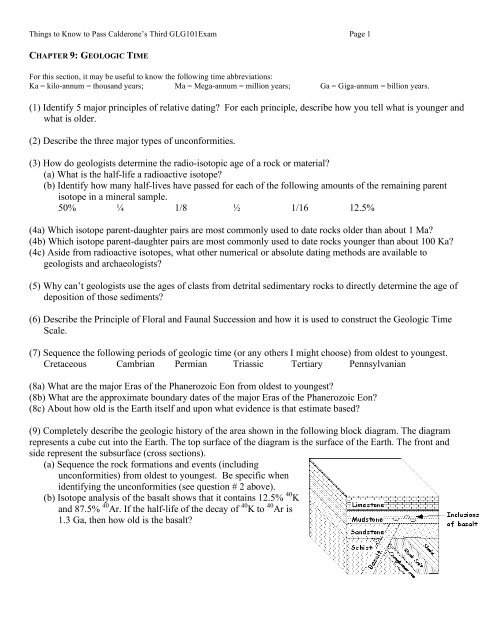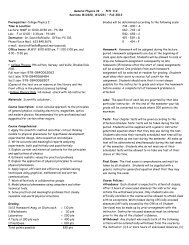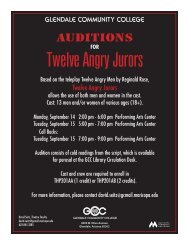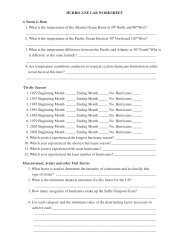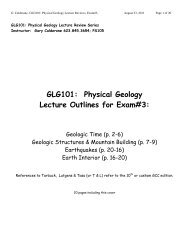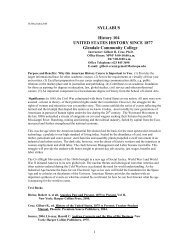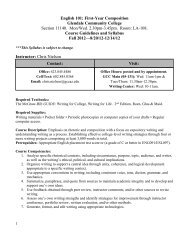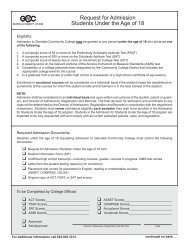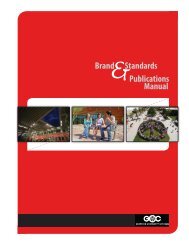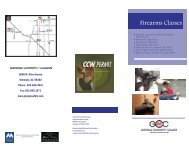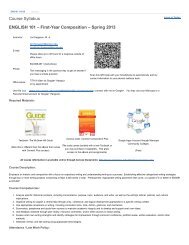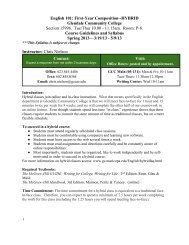Exam 3 Essay Questions (PDF)
Exam 3 Essay Questions (PDF)
Exam 3 Essay Questions (PDF)
- No tags were found...
You also want an ePaper? Increase the reach of your titles
YUMPU automatically turns print PDFs into web optimized ePapers that Google loves.
Things to Know to Pass Calderone’s Third GLG101<strong>Exam</strong> Page 1CHAPTER 9: GEOLOGIC TIMEFor this section, it may be useful to know the following time abbreviations:Ka = kilo-annum = thousand years; Ma = Mega-annum = million years; Ga = Giga-annum = billion years.(1) Identify 5 major principles of relative dating? For each principle, describe how you tell what is younger andwhat is older.(2) Describe the three major types of unconformities.(3) How do geologists determine the radio-isotopic age of a rock or material?(a) What is the half-life a radioactive isotope?(b) Identify how many half-lives have passed for each of the following amounts of the remaining parentisotope in a mineral sample.50% ¼ 1/8 ½ 1/16 12.5%(4a) Which isotope parent-daughter pairs are most commonly used to date rocks older than about 1 Ma?(4b) Which isotope parent-daughter pairs are most commonly used to date rocks younger than about 100 Ka?(4c) Aside from radioactive isotopes, what other numerical or absolute dating methods are available togeologists and archaeologists?(5) Why can’t geologists use the ages of clasts from detrital sedimentary rocks to directly determine the age ofdeposition of those sediments?(6) Describe the Principle of Floral and Faunal Succession and how it is used to construct the Geologic TimeScale.(7) Sequence the following periods of geologic time (or any others I might choose) from oldest to youngest.Cretaceous Cambrian Permian Triassic Tertiary Pennsylvanian(8a) What are the major Eras of the Phanerozoic Eon from oldest to youngest?(8b) What are the approximate boundary dates of the major Eras of the Phanerozoic Eon?(8c) About how old is the Earth itself and upon what evidence is that estimate based?(9) Completely describe the geologic history of the area shown in the following block diagram. The diagramrepresents a cube cut into the Earth. The top surface of the diagram is the surface of the Earth. The front andside represent the subsurface (cross sections).(a) Sequence the rock formations and events (includingunconformities) from oldest to youngest. Be specific whenidentifying the unconformities (see question # 2 above).(b) Isotope analysis of the basalt shows that it contains 12.5% 40 Kand 87.5% 40 Ar. If the half-life of the decay of 40 K to 40 Ar is1.3 Ga, then how old is the basalt?
Things to Know to Pass Calderone’s Third GLG101<strong>Exam</strong> Page 2CHAPTERS 10 & 14: GEOLOGIC STRUCTURES, CRUSTAL DEFORMATION AND MOUNTAIN BELTS(10) Describe the 3 major types of stress. For each stress, tell with which plate boundary it is associated.(11a) What is the difference between elastic and inelastic strain?(11b) What are the two main kinds of inelastic strain?(12) Draw each of the following geologic structures in sedimentary layered rocks (use at least three layers) inboth cross sections and map view (after erosion of the structure). Alternatively, you may draw both using ablock diagram. Use strike and dip symbols on the map view to indicate dip directions.(a) anticline (b) syncline (c) plunging anticline (d) plunging syncline(e) dome (f) basin(13) Draw a normal and reverse fault in cross section. For each fault:(a) Identify the hanging wall block(b) use arrows to show motion of both the hanging and footwall blocks(c) tell which overall stress field most likely produced the fault(14) Draw a right-lateral and left-lateral fault in map view. For each fault:(a) use arrows to show motion of each block(b) tell which overall stress field most likely produced the fault(15) What type of strike slip fault is the transform faultconnecting the ridges shown at right?(16) Describe the four types of mountain belts. Give realworld examples of each type.CHAPTER 11: EARTHQUAKES(17a) Describe three major causes of earthquakes.(17b) Where do most earthquakes on the planet originate?(18) Define the following terms in seismology:(a) Focus(b) Epicenter(c) Aftershock(19) Describe the 4 major types of seismic waves including:(a) What is the motion of the ground as the wave passes?(b) Through what materials can/can’t the wave pass?(c) Is the wave a body or surface wave?(d) What is the wave velocity relative to other waves?(e) How damaging is the wave to man-made structures?(20a) Describe the major effects of earthquakes.(20b) How does the local geology influence each effect?(21) What methods do geologists use to predict earthquakes in the long term?
Things to Know to Pass Calderone’s Third GLG101<strong>Exam</strong> Page 3(22) How do we use seismic waves to locate an earthquake? I.e. how many seismograms do we need to locatethe epicenter of an earthquake?(23a) How deep are most earthquakes at divergent boundaries andtransform faults? Why are there no deep focus earthquakes inthese environments?(23b) How do we explain the Benioff-Wadati zone of deep andintermediate focus earthquakes?(23c) In the diagram at right, use the epicenters of deep focusearthquakes to determine which plate is subducting.(24) How does the Richter Scale work in terms of ground motion and energy release? That is, for every changeof 1 number on the scale, how do the wave amplitudes and energy releases change?CHAPTER 12: EARTH’S INTERIOR(25) Describe the evidence that allows us to construct a model of the Earth's interior. Be sure your discussionincludes the evidence from:(a) seismology(b) the Earth's gravity field(c) the Earth's magnetism, and(d) meteorites.(26a) How do the velocities of seismic waves vary with the material through which they travel?(26b) The Mohorovicic Discontinuity is the boundary between which two of Earth’s layers?(26c) The Low Velocity Zone is evidence for which layer of the Earth?(26d) What are seismic shadow zones and what do they tell us about Earth’s interior?(27a) Draw and describe a geologic cross section that would produce a positive gravity anomaly.(27b) Draw and describe a geologic cross section that would produce a negative gravity anomaly.(28) Gravity considerations suggest that large mountain ranges such as the Himalaya should exhibit gravityanomalies. Yet such anomalies are not typically observed. Why not?(29) Predict what would happen to the lithosphere/asthenosphere boundary in an isostatically compensated areaunder the following conditions:(a) addition of a large volume of glacial ice in the area.(b) erosion of a large mountain range in the area.(c) deposition of sediments in an ocean basin in the area.(d) overthrusting of another land mass onto the area.(30) What generates the Earth’s magnetic field?(31a) Draw and describe a geologic cross section that would produce a positive magnetic anomaly.(31b) Draw and describe a geologic cross section that would produce a negative magnetic anomaly.


